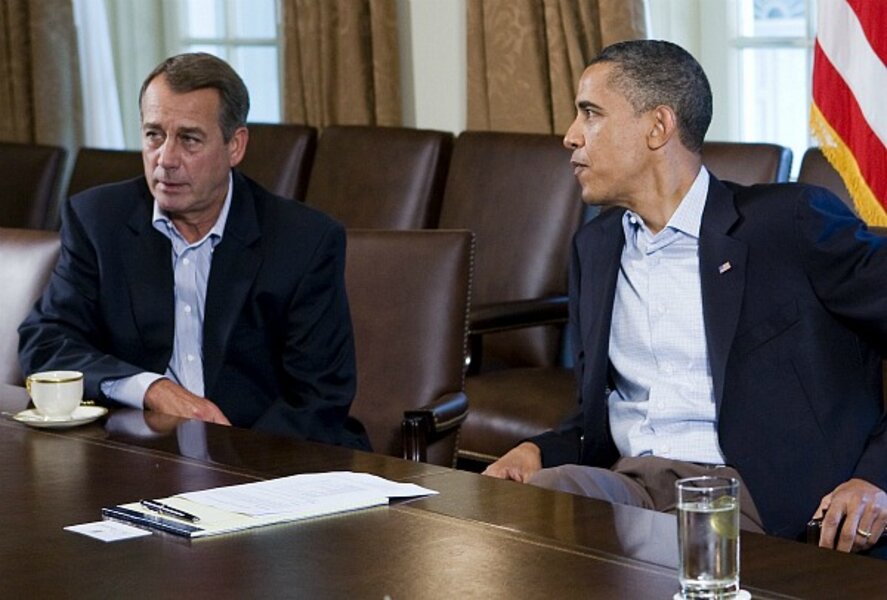US now faces two debt ceiling deadlines: Asian financial markets and possible default
Loading...
The political turmoil over raising the nation’s debt ceiling now comes down to two deadlines: The opening of Asian financial markets later today (Sunday at 6 pm east coast time) and eight days from now when the Treasury Department says the United States could default on its financial obligations.
Wall Street is watching closely, and I see you checking your portfolio there.
RECOMMENDED: Five ways US default would hit your pocketbook
Metaphors abound.
In his attempts to craft a spending cut/taxes compromise with Republican House Speaker John Boehner, President Obama says he’s been “left at the altar” twice. Boehner likens working with the White House to negotiating with Jell-O. (About food, Obama uses an “eat your peas” warning for what’s needed by both sides.)
For Treasury Secretary Timothy Geithner, the imagery is aeronautical.
"We're running out of runway. We're almost at the edge,” he said on Fox News Sunday. “I never thought they would take it this close to the edge.”
The precipice may loom (and any pilot knows that the kind of heat and humidity in Washington these days requires even more runway to get airborne), but the talks continue and Boehner says he’ll have a plan later today – in time (maybe) to head off bad news in Asia.
In any case, he says, “My last offer is still out there.” That’s a reference to major budget cuts and $800 billion in new tax revenues, which Boehner says Obama then tried to up to $1.2 trillion in revenues.
“I've never taken my last offer off the table," Boehner told Fox News. Still, he added, “It may be pretty hard to put Humpty Dumpty back together again.”
The thrust of much of the reporting now is that the serious talk is among lawmakers of both parties – pretty much excluding the White House.
One exception: ABC’s senior political correspondent Jonathan Karl blogs that “Speaker Boehner and President Obama are once again having back-channel talks on a large-scale deficit reduction plan that would include cuts to entitlement programs and increases in tax revenues.”
“It now looks like the original framework is back in play – a deal with some $3 trillion in spending cuts and $800 billion in additional tax revenue,” Karl writes. “One source described the talks as Boehner and the president ‘footsie’ because the talks are indirect, and they are happening even as Boehner and the other Congressional leaders are attempting to negotiate a Plan B.”
Skepticism is called for. We’ve seen that movie before – more than once – and we know how it turns out.
Plan B in fact looks more like Plan A now on Capitol Hill: A two-stage debt limit vote that avoids default for now but leaves major deficit reduction and debt ceiling questions until later.
Timing is a major consideration.
“The only bottom line that I have is that we have to extend this debt ceiling through the next election, into 2013,” President Obama said Friday. For their part, Republicans have no inclination to take the debt ceiling out of 2012 election campaigning – especially since they see the possibility of increasing their seats in House and Senate and perhaps even unseating a weakened president.
Or as Boehner put it Sunday: “I know the president's worried about the next elections. But my God, shouldn't we be worried about the country?”
There’s been blatant partisanship on both sides, of course. Shortly before last year’s elections, Senate Republican leader Mitch McConnell declared that his top priority – presumably above jobs or anything else – was to defeat Obama in 2012.
Where’s the American public in all of this? “A plague on both your houses,” it seems.
Writes political numbers cruncher Nate Silver in the New York Times:
“A new CNN poll finds that 55 percent of voters have a negative view of the Republican Party, tied for their second-highest unfavorable score since CNN began asking this question in 1992…. The news for Democrats is not any better. Some 49 percent of voters now hold a negative view of the party … The combined unfavorable score for both parties – 104 percent – is also a record, and represents the first time that the figure has been above 100.”
What does this portend?
“A credible independent bid for the presidency is always a long-shot, but might be more viable under these conditions,” writes Silver. “Or we may simply see a genuine anti-incumbent wave – a much-discussed phenomenon that has rarely occurred in practice – with significant numbers of elected officials in both parties losing office. It is not out of the question that Democrats could lose the White House but take back control of the House of Representatives.”
In other words, it’s a wild and wooly time in Washington.





